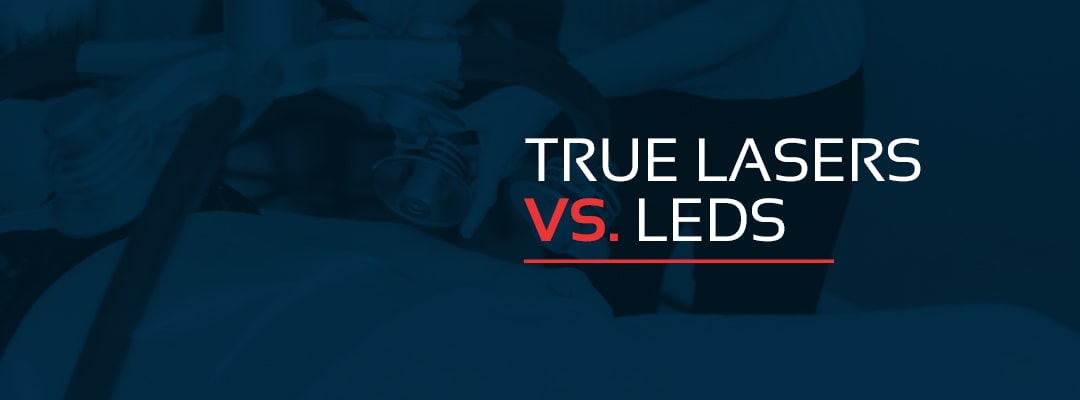
There are numerous lasers and light-emitting diodes (LEDs) available that work for various medical applications. While LEDs may be effective in some instances, many fall short of the true potential power that real laser therapy offers. When compared to true lasers, LEDs can only deliver a smaller portion of energy into the body tissue. Alternatively, low-level laser therapy can provide more robust energy delivery and can apply to numerous medical situations.
What Is Laser Light?
The term laser stands for light amplification by stimulated emission of radiation. A laser is a mechanism designed to emit electromagnetic radiation through the process of stimulated emission. It concentrates its power into packets of energy called photons that penetrate the body’s tissues, allowing physicians to effectively target a treatment area, such as treating chronic back pain.
Some of the main characteristics of laser light include:
- Monochromatic: Laser light consists of a narrow range of wavelengths, making lasers ideal for absorption into the tissue.
- Coherent: Coherence is one of the most important aspects of laser light, responsible for the total distance traveled and the penetration capabilities of the light. Light coherence is what makes the light energy able to have a beneficial effect on a deeper level.
What Are LEDs?
A light-emitting diode, more commonly referred to as an LED, is a light emitting diode. An LED has characteristics between a laser and a light bulb. When an LED activates, the electrons can reconnect with electron holes located in the device. This reconnection causes an energy release in the form of photons. The color of the emitted light directly defines the light’s properties and corresponding energy emission.
Earlier forms of LEDs would emit red light of low intensity. With modern innovations, LEDs are available in a more extensive selection of wavelengths, including infrared, which is often required for deep tissue penetration. LEDs are a non-coherent and divergent light source, meaning the light radiates in all directions. While LEDs can switch quickly, they can’t super-pulse.
Comparing Laser Light and LEDs
One of the most important differences between the light emitted by an LED and that of a laser is the LED light is non-coherent and divergent. Because LED light is divergent, it wastes more energy and requires more specialized optics to focus the available energy into the desired areas. Alternatively, lasers waste less energy and can precisely target a treatment area more effectively.
- Low divergence: Lasers are ideal for targeting specific areas of the body as they have a low divergence.
- Coherence: Laser light is coherent, while LED light isn’t.
- Efficiency: Laser light is significantly more effective and efficient at delivering energy to the body’s tissues.
Are Lasers More Effective Than LEDs?
Therapeutic depth is the process of delivering an adequate amount of light energy to the treatment area to improve symptoms. Lasers are significantly more efficient at reaching a therapeutic depth and properly delivering energy. Because a significant amount of light energy is lost as it passes through the body’s tissues, the laser must have a higher initial power at the surface, improving the laser’s ability to provide adequate amounts of energy at various depths.
Applications for Low-Level Laser Therapy
Low-level laser therapy is a versatile treatment that can improve various medical conditions. Cold laser therapy, also known as a cold laser treatment, is a fast and painless process that can relieve multiple symptoms. Another benefit of cold laser therapy is that it’s non-pharmacological, meaning laser therapy can help manage painful symptoms and be a helpful alternative to opioid medications.
Physicians regularly use laser treatments because it’s safe and effective. Additionally, laser treatments can help patients avoid extensive surgery, often accompanied by a lengthy recovery period and painful side effects. While traditional surgery may be necessary in some cases, it’s often recommended to avoid extensive surgery if a non-invasive treatment option exists.
Common low-level laser treatments include:
Benefits of Low-Level Laser Therapy
Low-level laser treatments are a practical option for those looking to contour the body or treat chronic pain or foot fungus. A typical low-level laser treatment is performed in approximately 30 to 40 minutes but will vary from patient to patient. Most patients receive three laser treatments a week for two weeks, totaling six treatments in all. However, the total number of procedures will depend on what you’re having treated.
Because laser treatments are non-surgical, patients experience no pain or discomfort during treatment and can immediately return to their daily activities. Additionally, non-surgical fat loss treatments don’t require incisions, shortening downtime and preventing any potential scarring. Unlike traditional procedures, laser treatments don’t need any form of anesthesia, making the recovery period significantly shorter.
In general, non-invasive therapies can provide effective treatments while prioritizing patient safety.
Erchonia Is the World Leader in Low-Level Laser Technology
Erchonia is committed to the advancement of low-level laser therapy through clinical and scientific research. We’re committed to quality — not compromise — and pride ourselves on the rigorous process we follow to provide a viable treatment modality. We’re the world leader in low-level laser technology and are proud to offer effective, safe solutions designed for health clinics, physical therapists, chiropractors and veterinarians worldwide.
Our products include lasers for fat loss, lasers for pain and lasers for foot fungus. We strive to provide our clients with the highest level of products and customer service possible. Our clinical research shows the safety, efficacy and efficiency of low-level laser treatments.
Learn more about low-level laser treatments and find a provider near you or contact us today.
Find a ProviderBecome a Provider



